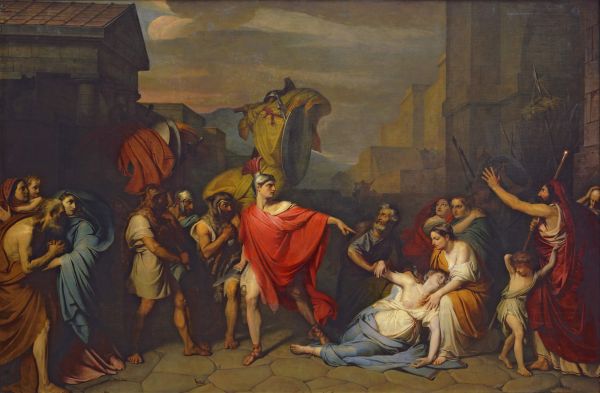|
|
Bruni Fyodor. The Death of Camilla, Sister of Horatius. 1824

Bruni Fidelio (Fyodor)
350 x 526,5
Пост. в 1897 из Императорской Академии художеств; ранее (с 1824 по 1833) – в имении князя Барятинского; в 1833 была выставлена и в 1834 приобретена ИАХ.
Annotation
23-year-old Fyodor Bruni took this subject from the legendary past when Rome was at war with the city of Alba Longa. The fate of this longstanding feud was to be determined in the fight between the three brothers Horatii – from the side of Rome, and three brothers Curiatii – from Alba Longa. Returning to Rome, the victorious survivor Horatius sees his sister Camilla mourning the death of her fiancé, one of Curiatii, instead of her brothers’. Enraged, her brother strikes her with his sword. The act of the hero is met by part of the witnesses with horror and compassion for his victim.
These emotions are also communicated to the audience; and it is no coincidence that F. A. Bruni’s painting, initially named by the author “Triumph of Horatius”, was renamed by his contemporaries to "The Death of Camilla, Sister of Horatius".
But here, like in no other Russian historical painting, the triumph of community spirit and determination to sacrifice their personal and most precious everything for the public debt is immortalized. In a strong imperative gesture of Horace, in mimics of other characters, in colour scheme, a drama so intense is expressed, as could not be found in previous works by the Russian historical painters.
The action of this painting unfolds before us like a classical frieze: the plastic of figures placed on the stage is carefully modelled, their gestures are majestic, large folds of the draperies fall nobly. A scarlet cloak and a striking pose lay emphasis on the hero placed in the centre – his pointing hand is exactly congruent with the diagonal composition. The painting’s clear classic scheme echoes J. L. David's painting "Oath of the Horatii" (1784, Louvre).
The painting was given to the Russian Museum in 1897 from the museum of the Academy of Arts; earlier (from 1824 to 1833) it was stored in the estate of the Prince Baryatinsky; in 1833 it was exhibited and in 1834 purchased by the Imperial Academy of Arts.
Author's Biography
Bruni Fidelio (Fyodor)
Bruni, Fidelio (Fyodor Antonovich)
1801, Milan -1875, St Petersburg
Painter, engraver, author of religious and history compositions, portraitist. Son of the painter and sculptor Antonio Baroffi-Bruni. Moved to Russia with his father (1807). Studied under Alexei Yegorov, Andrei Ivanov and Vasily Shebuyev at the Imperial Academy of Arts (from 1809). Graduated with a first-class degree (1818). Moved to Rome to con¬tinue his art education (1819). Returned to Russia and painted portraits and icons for churches and cathedrals in St Petersburg and environs (1835-38). Lived and worked in Rome (1838-43, 1843-45). Honorary member of the Academies of Art of Bologna and Milan, professor of the Florentine Academy of Arts and St Luke''s Academy in Rome. Taught at the Imperial Academy of Arts (1836-38, 1846-71). Second-class professor (1836), first-class professor (1846), rector of painting and sculpture (1855-71). Curator of the Imperial Hermitage picture gallery (1849-64), headed the mosaic studio at the Imperial Academy of Arts (from 1866

